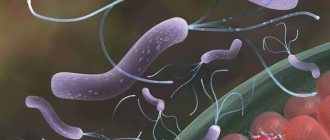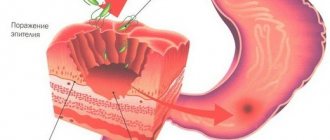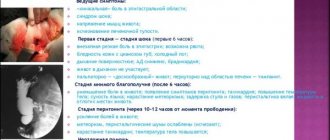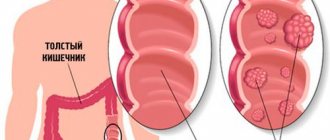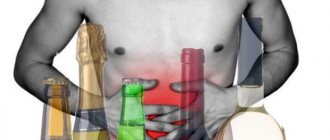Duodenal ulcer (DU) is a chronic recurrent disease characterized by deep damage to the inner mucous layer of the duodenum, causing the development of deep defects in the submucosal and muscular layer of the intestinal wall. The disease is characterized by a long course with phases of exacerbation and remission. It was noted that among the 15% of citizens who fall ill each year, a third are tall, thin men.
The key factor in the development of duodenal ulcer is the infectious influence of Helicobacter, which in 98% of cases is cultured during examination of patients. But this factor may not always be decisive; in many cases, the presence of bacteria can be the so-called asymptomatic carriage.
They contribute to the formation of ulcerative pathology - disturbances in the humoral and nervous mechanisms responsible for the regulation of trophic processes in the duodenum. Which leads to the formation of one or several ulcers. The impetus for the development of the pathological process can be:
- incorrect and irregular diet;
- frequent stressful situations and decreased activity;
- high secretion of stomach acid;
- gastroprotective and non-steroidal drugs;
- nicotine effect (especially if smoked on an empty stomach)
- gastrin-producing neoplasms.
Treatment regimen for duodenal ulcer
Treatment according to modern principles is active drug therapy, the use of several components to draw up a treatment regimen, and a long course of medication, if indicated.
There are no fundamental differences in therapeutic regimens for gastric and duodenal ulcers; doctors adhere to the following principles in both cases:
- elimination of the causative factor;
- taking into account concomitant pathology and its adequate treatment. Drug correction should be carried out in case of pathology on the part of any organs and systems;
- the individuality of each organism is taken into account (weight, height, physical activity, possession of all self-care skills, intolerance to certain groups of drugs);
- the patient's capabilities (material well-being).
Treatment of duodenal ulcers should follow the following principles:
- etiological treatment;
- patient compliance with the prescribed treatment regimen;
- treatment with diet (special nutrition);
- mandatory drug therapy, taking into account schemes developed over the years;
- herbal medicine and treatment with folk remedies in general;
- physiotherapy methods;
- use of mineral waters;
- local treatment of ulcers that are prone to long-term persistence (do not heal).
Additional treatments
In addition to drug treatment, the patient will be offered physiotherapeutic methods that will help speed up the recovery process. Their action is aimed at strengthening the body, as well as normalizing impaired functions of the digestive organs.
Physiotherapy may consist of the following methods:
- Application of warm compresses
. Experts say that heat has a beneficial effect on the body. It helps reduce pain and improve blood circulation. - Spa treatment
. A trip to the resort is accompanied by wellness treatments. The patient’s recovery after illness will be facilitated by a favorable climate and drinking the best mineral water, for example, “Essentuki” or “Borjomi”. - Health-improving physical education classes
. It consists of physical exercises that improve blood circulation, eliminate congestion in the body and stimulate appetite.
All physiotherapeutic procedures must be supervised by the attending physician. He is obliged to monitor the health of his patient.
To avoid surgery and a long recovery period, people should seek help from a gastroenterologist after the first alarming symptoms. After all, they may indicate an ulcer, which without proper treatment can develop into a malignant tumor.
Also, advanced disease leads to other serious complications.
So you shouldn’t put your health at risk again. It is better to immediately make an appointment with a doctor in order to promptly stop the signs of a dangerous illness that can greatly worsen the quality of life. Published: June 30, 2020 at 08:58 pm
When a duodenal ulcer is diagnosed, medication treatment forms the basis of conservative therapy.
Medications for duodenal ulcers belong to the following pharmacological groups:
Eliminating the causes of the disease
Of particular importance in the occurrence of ulcers of the duodenal bulb and extra-bulb forms is given to the microbial component, namely Helicobacter pylori. According to some data, in 100% of cases, ulcers localized in the duodenum are associated with these bacteria.
The use of anti-Helicobacter therapy can reduce the number of relapses, ensure a long period of remission, and in some cases complete recovery, therefore treatment with antibacterial agents is superior in effectiveness to all medications that are used to treat this disease.
When choosing agents for an anti-Helicobacter regimen, the specialist relies on its expected effectiveness, that is, after its use, a positive result is observed in 80% of cases (complete eradication of the pathogen).
Rules of anti-Helicobacter therapy:
- if the prescribed regimen is ineffective, its repeated use is not recommended;
- if the combination of drugs used does not give the desired result (disappearance of the pathogen), it means that the bacteria have developed resistance to any of its components;
- If the administration of two different antibacterial therapy regimens sequentially did not lead to the eradication of bacteria, then the sensitivity of this strain to all antibiotics used in the regimens to eliminate the bacterial agent should be determined, and then treated according to the results.
Subtleties of antibiotic therapy
The doctor must strictly follow and strictly adhere to the eradication regimen using antibacterial agents. The specialist takes as a basis the empirically proven effectiveness of drugs and the sensitivity of Helicobacter to them.
If the doctor is not confident in his abilities, it is better not to treat with antibiotics than to carry out the therapy incorrectly, thereby causing microorganisms to become resistant to all prescribed antibiotics. Therefore, an important stage is a conversation with the patient, confidence in his participation and fulfillment of the specialist’s prescriptions.
It is equally important to assess the patient’s economic capabilities, to let him know that a one-time expensive treatment is much more financially beneficial than refusing antibiotics and wanting to save money. After all, antibacterial therapy makes it possible to achieve a fairly stable remission in 80% of cases, which turns out to be the most economically beneficial.
How to choose the right antibacterial therapy regimen?
- Duodenal ulcers that occur due to increased production of hydrochloric acid are preferably treated with a standard three-component regimen based on proton pump blockers. Subsequently, a transition to taking only proton pump inhibitors without antibiotics is allowed. If the patient has previously used the nitroimiazoline group of drugs, even for the treatment of another disease, then metronidazole and tinidazole are contraindicated.
- Use of macrolides. Since the resistance of different Helicobacter strains to the nitroimidazoline group of antibiotics has recently increased, experts began to give preference to macrolides. Treatment with macrolides turned out to be quite effective, since they are able to penetrate into cells and be released through the mucous membranes. In addition, antibiotics of this group have fewer contraindications and side effects than, for example, tetracyclines. But there is a feature that must be taken into account when prescribing them: they are destroyed by hydrochloric acid, and, as is known, ulcers are often accompanied by a hyperacid state. Therefore, the most resistant representatives of the group, clarthromycin, are suitable for anti-Helicobacter therapy. The regimen is used as follows: Omeprazole (20 mg) + clarithromycin (at a dose of 500 mg twice a day) + amoxicillin (twice a day, 1 thousand mg). The effect reaches 90%.
- The rapid elimination of signs of dyspeptic disorders is facilitated by the prescription of antisecretory drugs together with antibiotics. In addition, such combinations accelerate the elimination of Helicobacter pyloricus and the scarring of ulcerative defects. Antisecretory drugs increase the viscosity of gastric secretions, so the time of action of antibiotics on bacteria and the concentration of antibacterial drugs in the stomach contents increase.
Examples of combination therapy:
- First line: proton pump inhibitor (bismuth citrate ranitidine can be used) in the usual therapeutic dose once a day + antibiotic Clarithromycin 500 mg, twice a day + antibiotic Amoxicillin 1 thousand mg. , twice a day (can be replaced with metronidazole 500 mg, twice a day). The course of the triple scheme is at least 7 days. Of the combinations of antibiotics, preference is given to Clarithromycin with Amoxicillin rather than with Metronidazole, which will affect the further result of treatment.
- If first-line medications do not produce results, a second line is prescribed: twice a day proton pump inhibitor + 4 times a day bismuth subcitrate at a dose of 120 mg. + Metronidazole at a dose of 500 mg. three times a day + Tetracycline 4 times a day at a dose of 500 mg. Therapy of four drugs is prescribed for 7 days (minimum course). If this scheme does not give a positive result, then the specialist determines further tactics in each individual case and treats individually.
Properties of the main types of drugs
Bismuth containing product De-nol
The main component of De-nol is bismuth tripotassium dicitrate, through which it is possible to achieve effective treatment of duodenal ulcers. De-nol has the ability to create a protective coating on the damaged area, which helps restore cells in the stomach wall and the ulcer heals faster. A similar effect of De-nol is achieved due to the astringent property of Bismuth to precipitate protein compounds by creating so-called chelate compounds with them, which form a protective film. A distinctive feature of De-nol is the ability to create such a film only on damaged areas
In addition to its protective functions, De-nol has excellent bactericidal properties after administration, which almost completely eliminates harmful bacteria. Such tablets for stomach ulcers effectively inhibit the enzymatic activity of pathogenic microflora, which becomes the main cause of its death. De-nol also completely disrupts the structure of the microorganism, after which the ability to adhere is lost.
It can be taken by both adults and children. But the dosage is determined only by the attending physician and completely depends on the characteristics of the course of the disease.
Usually the medicine must be taken four times a day, 1 tablet. There is also an alternative regimen in which De-nol is allowed to be taken twice a day, but the dosage of a single dose is 2 tablets.
Names of drugs that replace this drug:
- Pariet;
- Nexium.
Omez
Omez is a member of the drug group of proton pump inhibitors. The second name of this drug is Omeprazole. Omez begins to act immediately after taking it. After just 60 minutes, Omez inhibits stimulated hydrochloric acid by affecting various enzymes of gastric juice. Omez is effective for 24 hours.
Omez quickly and effectively affects daytime and nighttime production of hydrochloric acid. The full therapeutic effect can be seen after 4 days, the duration of which is observed for another 3 days without taking the drug. For patients suffering from peptic ulcers in the gastroduodenal zone, omez helps maintain the required level of acidity in the stomach cavity for 17 hours.
You can take Omez only once a day, washing down the capsule with a small amount of water. It should not be chewed or opened, as the medicine will immediately lose its properties. Women are not allowed to take it.
The drug can be replaced with Romesek, Zerotsid, Otsid, Helitsid.
H2-histamine receptor blockers
Such drugs inhibit the production of hydrochloric acid and the digestive enzyme pepsin. Famotidine and Ranitidine are recognized as the most effective today. Thanks to their properties, a favorable environment is formed for the action of antibiotics that eliminate pathogens. You can take them both before and after meals. The therapeutic effect of the drug does not decrease
M1 anticholinergics
This group is prescribed to reduce the tone of the gastric muscle, reduce the secretion of hydrochloric acid and the digestive enzyme pepsin. For treatment, a drug such as Pirenzepine is usually used. However, it is not currently used as an independent remedy in the treatment of ulcers.
Antacids and medications of this type
These are perhaps one of the most famous and “old” medications that were used to reduce the effects of gastric juice by causing it to react chemically with drugs.
Today, the best representatives are non-absorbable antacids, which are base salts. Most often they contain a combination of magnesium hydroxide and aluminum hydroxide (Maalox and Almagel), sometimes they are single-component preparations based on aluminum phosphate (Fofalugel).
Modern antacids have more advantages over earlier absorbable (soda-based) forms. They are able to increase the pH in the stomach cavity due to the formation of weakly or completely non-absorbable salts with hydrochloric acid. When the acidity is more than 4, the activity of pepsin is reduced, so some antacids adsorb it.
Thanks to information about the work of parietal cells and the basics of hydrochloric acid secretion, it has become possible to create drugs with fundamentally new mechanisms of action.
Three classes of receptors found on parietal cells control the secretion of hydrochloric acid: M-cholinergic receptors, H2-histamine receptors and G-gastrin receptors.
The first, historically, were drugs that act on muscarinic receptors. The drugs were divided into two groups: selective (pirenzipine) and non-selective (atropine). However, both groups have lost their importance in peptic ulcer disease, since more effective antisecretory agents have appeared on the pharmacological market that work at the molecular level and interfere with subtle processes inside cells.
Medicines of the group of H2-histamine receptor blockers
Medicines in this group helped to establish control over the secretion of hydrochloric acid during the day. The pH level and the ability of medications to influence it directly affect the healing time of ulcerative defects. Healing of defects directly depends on the duration of administration of antisecretory agents and on their ability to keep the cavity pH level above 3 for the required time. If you maintain the pH inside the duodenum above 3 for 4 weeks from 18 to 20 hours a day, then the ulcers heal in 100% of cases.
Advantages of H2-histamine blockers:
- the time for scarring of pathological lesions has been significantly reduced;
- on average, the number of patients in whom it was possible to achieve scarring of defects has increased;
- the percentage of complications of peptic ulcer disease has decreased significantly.
The main representatives of the group of H2 blockers.
- Ranitidine. Prescribed for duodenal ulcers for up to 4 weeks, at a dose of 300 mg per day. Can be taken once or divided into two doses (morning and evening). In order to prevent relapses, the patient is recommended to take 150 mg of the drug daily.
- Kvamatel (Famotidine). A single dose of the drug provides an antisecretory effect for up to 12 hours. is prescribed in a dosage of 40 mg, the course is similar to that for Ranitidine. For a preventive course, 20 mg per day is sufficient.
Tablets of this group play an important role in stopping bleeding from defects in the upper parts of the digestive tube. They are able to indirectly reduce fibrinolysis by inhibiting the production of hydrochloric acid. Of course, in the presence of bleeding, preference is given to forms with parenteral administration (Kvamatel).
The greater effectiveness of medications from the group of H2-blockers is mainly due to the inhibition of hydrochloric acid synthesis. Different representatives have different periods of antisecretory effects: Ranitidine works up to 10 hours, Cimetidine - up to 5, Nizatidine, Famotidine, Roxatidine - up to 12 hours.
What signs indicate the presence of a stomach and duodenal ulcer?
Peptic ulcer disease is characterized by a set of general symptoms that indicate the presence of a disease of the digestive tract. Some of them - pain, nausea, vomiting, heartburn - may be manifestations of gastritis.
Another article on this topic: Esophageal ulcer: what is it and how to treat?
Abdominal pain and other signs of disease with an ulcer are not always present. Remission can be long-term if the patient monitors nutrition and eliminates bad habits and stress.
But even the slightest error in nutrition or strong emotional experience can lead to exacerbation and intensification of symptoms.
| Symptoms of a stomach ulcer | Symptoms of duodenal ulcer |
| The pain is localized in the upper abdomen, above the navel. Decreases after taking antacids. | Pain in the upper abdomen that occurs at night and early in the morning. Does not always decrease after taking antacids. Eating helps reduce pain. |
| Appetite worsens. | There is often heaviness in the abdomen and increased gas formation. |
| Heartburn and belching are common concerns. | Belching sour. Belching that smells like rotten eggs indicates stenosis. |
| Nausea occurs within an hour after eating. | Nausea occurs one and a half to two hours after eating. |
| Vomit often contains blood clots. | Vomit contains undigested food. If there is bleeding, vomiting “coffee grounds” occurs - this is blood that has reacted with gastric juice. |
| The stool is dark in color and often contains an admixture of partially digested blood. | During an exacerbation of an ulcer, constipation often occurs due to decreased intestinal motility. |
Proton pump inhibitors
As is known, parietal cells possess an enzyme that ensures the transport of hydrogen ions from the cell to the stomach cavity. This is H+K+ATPase. Experts have developed agents that block this enzyme, forming covalent bonds together with sulfhydryl groups, which disables the proton pump forever. Resumption of hydrochloric acid synthesis begins only after the synthesis of new enzyme molecules.
To date, these are the most powerful drugs for inhibiting the secretion of hydrochloric acid. Main representatives: Pantoprazole, Omeprazole, Rabeprazole, Lansoprazole, De Nol.
During the day, proton pump inhibitors are able to maintain the pH value for a long time at a level when the healing of mucosal defects is most effective, that is, a single dose of the drug has an effect from 7 to 12 hours, keeping the pH above 4. This can explain the amazing clinical effectiveness of proton pump inhibitors . Thus, a duodenal ulcer heals in 75-95% of cases within 2 to 4 weeks, and dyspeptic symptoms disappear in 100% of cases within a week.
Antisecretory agents
Indispensable drugs in the treatment of duodenal ulcers. Medicines inhibit gastric secretion, reducing the aggressive effect of hydrochloric acid on the defect in the small intestinal mucosa.
The group of these drugs is heterogeneous. It includes:
- H2 blockers (histamine receptors): Famotidine, Ranitidine. Medicines reduce the daily production of acid by the stomach by 60%, preventing the acidic environment from corroding the intestinal mucosa. Famotidine has a longer pharmacological action than ranitidine. Blockers create the most favorable environment for antibiotic therapy, making treatment aimed at destroying Helicobacter pylori the most effective.
- M1 (anticholinergics): Pirenzepine. A remedy for duodenal ulcers that can reduce the amount of stomach acid and pepsin. And also relieve muscle tone. Used as an auxiliary drug to the main treatment.
- Omez, Omeprazole, Zerotsid are proton pump inhibitors. The newest remedy for duodenal ulcers, a single dose of which suppresses the secretory function of the stomach by 80%, reducing the daily amount of hydrochloric acid and the enzyme pepsin. The combined use of inhibitors and antibiotics has the most productive effect on the bacterial infection Helicobacter pylori, suppressing it.
De-Nol, Vikair, Vikalin, inhibit the viability of pathogenic microorganisms Helicobacter pylori, form a protective film that prevents the aggressive effect of acid on the intestinal defect.
Medicines for duodenal ulcers containing bismuth, while inhibiting the activity of bacteria, do not affect the properties of the juice produced by the stomach. When treated with bismuth-containing medications, stool turns black.
Ranitidine (bismuth citrate) and Sucralfate are complex effective remedies for duodenal ulcers, which have an antacid, protective and suppressive effect on Helicobacter pylori.
Modern auxiliary drugs
The basis of this group is made up of medications that affect the motility of the digestive tube. They are aimed at both its activation and oppression.
- Motility inhibitors: peripheral anticholinergics (chlorosil, metacin, platifillin), myotropic antispasmodics (halidor, no-spa, papaverine).
- Motility-activating prokinetics. Representatives: Domperidone (commercial name Motilium), Metoclopramide (Cerucal), Cisapride (Coordinax, Propulsid).
A duodenal ulcer is accompanied by dyskinesia (intestinal, cystic, esophageal), which manifests itself as a pain syndrome of spastic origin. These manifestations can be treated with oral forms of antispasmodics.
It is advisable to supplement the main treatment of the disease with prokinetics in the event of frequent attacks of reflux esophagitis, impaired gastric emptying, which often occurs against the background of inflammatory-spastic obstruction of the pyloroduodenal sphincter. The presence of a diaphragmatic hernia also justifies the use of prokinetics.
Severe spasticity of the pyloroduodenal zone is relieved by prescribing atropine in a dose of 20 to 25 drops once a day, the course can last several days.
The period of exacerbation of the disease is accompanied by many disorders of the digestive system: dyskinesia of the pyloroduodenal zone, constipation, dysfunction of peristalsis of both the small and large intestines. In the case of an acute form, the prescription of selective forms of prokinetics is justified. For example, Cesapride (aka Propulsid, Coordinax). It subtly affects the smooth muscle fibers of the digestive tract, stimulating the release of acetylcholine in the nerve cells of the Auerbach nerve plexus. Even persistent painful constipation, serious disorders of peristalsis and motility are effectively corrected with the help of this medicine.
Information about the selective effect of Cesapride, in contrast to Cerucal and Motilium, will be important for the patient. In addition, Cesapride is able to relieve the patient from gastroesophageal reflux by increasing the tone of the lower esophageal sphincter. The absence of systemic manifestations of Cesapride therapy is associated with its point of application: it works not through its effect on dopamine receptors, but by releasing the neurotransmitter acetylcholine. The selectivity of the drug’s action can also be explained by its effect on another receptor - serotonin, which affects the contraction of the muscles of the digestive tube only.
Prokinetics are prescribed before meals and before bed, at a dose of 0.01 grams, taken 3-4 times a day. Treatment at home is long-term – up to 3-4 weeks.
Therapy for peptic ulcers
In case of ulcerative pathology, you should never self-medicate, since the pathology is considered very dangerous for the body. Therefore, when the disease is diagnosed, the patient is immediately prescribed inpatient therapy. The prohibition to treat an ulcer at home is most often associated with its transition to an acute form, since it is at this stage that the disease is usually determined.
In a hospital setting, the patient is immediately determined by the procedure for the treatment course of a peptic ulcer, the scheme of which is aimed at restoring the damaged area. For a full recovery, the patient needs complete emotional and physical rest.
Drug treatment of stomach ulcers includes the following groups of drugs:
- Antisecretory drugs;
- Antacids.
- Medicines containing bismuth;
- Prokinetics;
- Antibiotics and antiprotozoal drugs;
- Vitamins.
It should be noted that when choosing a treatment course for peptic ulcer disease, one should take into account the versatility of the action of individual medications. This means that some of them combine both the ability to neutralize stomach acidity and form a protective layer. Taking into account such nuances, you can not only save money, but also minimize the harmful effects of individual components on the entire body.
Remedies in the treatment of duodenal ulcers
Their use is theoretically justified, since dysregulation and imbalance of protective and repair factors of the inner lining play a certain role in the development of foci of inflammation on the mucous membrane. The only “disadvantage” of such drugs is their unproven effectiveness. For example, the use of solcoseryl, Filatov serum, methyluracil, aloe extract and FIBS did not lead to a noticeable acceleration of mucosal repair.
Treatment of duodenal ulcers is carried out successfully and with the help of interventions during endoscopic examination. It can be treated with laser irradiation, local injection with medicines, substances, and sealing. All of these methods are prescribed to patients with ulcers that are resistant to conservative methods of eliminating ulcers. The main goal is to stimulate reparative processes.
Oxygen therapy produces positive changes in the microvasculature of the mucous membrane. This is breathing oxygen, which is supplied under pressure.
The mentioned therapeutic methods are only auxiliary, since their implementation is possible in large cities, requires some effort, but most importantly, they do not solve all the problems that are included in the list of goals for the rehabilitation of patients. That is why treatment must be comprehensive.
Other treatment options for duodenal ulcer: diet and folk remedies
In addition to the listed methods, the modern treatment regimen includes mandatory recommendations for the diet of a patient with duodenal ulcer. Good reviews can be heard among patients about therapy with folk remedies such as propolis, sea buckthorn oil and alcohol. It is worth remembering that completely abandoning drug treatment in favor of home recipes usually leads to a worsening of the situation. They should be used in combination with traditional methods, and only then will the therapy be effective.
Taking essential medications
Antibiotics alone cannot get rid of gastrointestinal ulcers.
The patient will require complex therapy, which includes the following types of medications:
- Products that solve the problem of high acidity (Omeprazole, Almagel, Famotidine).
- Medicines that destroy pathogenic bacteria (Denol, Oxacillin, Metronidazole).
- Antispasmodic drugs (“No-shpa”, “Papaverine”).
Patients often see the name “Denol” in prescriptions. This remedy is included in the main treatment regimens for peptic ulcers. It can be combined with other drugs. Denol should be taken 4 times a day.
Встречи на высшем уровне с настоящей моделью, лучшие проститутки Нижнекамска, отдых для истинных джентльменов с wownizhnekamsk.ru. Преимущества современных куртизанок неоспоримы, но каждая проститутка хороша по-своему. Темпераментные лучшие проститутки Нижнекамска, восхитительные и горячие, они такие изобретательные и оригинальные, что у любого появится желание. Твои мечты и желания реализуются.

